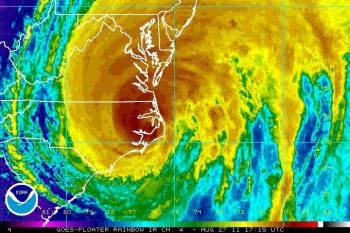Hurricane Irene: NOAA’s Efforts Before, During and After
Hurricane season for the National Oceanic and Atmospheric Administration (NOAA) is much more than just naming hurricanes. Even before Irene became the first hurricane of the season, NOAA was tracking her. Things kicked into high gear when Irene formed as a hurricane and appeared headed for landfall.
BEFORE
On Tuesday, August 23rd, NOAA forecasters began tracking and forecasting the track of the recently declared Hurricane Irene as it entered the southeastern Bahamas. As it turned out, this track forecast was remarkably accurate. The 48-hour error for Irene was 20 percent better than the 5-year average, and during the time that watches and warning were in effect for the United States, the average 48-hour track error was half of what it would have been 15 years ago. NOAA has a video of the accuracy of the prediction. The accuracy of this forecast is due to the guidance from the forecast model, advances in satellite-based observations and supercomputers, as well as the regular surveillance missions of the NOAA Gulfstream-IV beginning on August 23rd, allowing NOAA forecasters to watch the development of the storm.
On Friday, August 26th, NOAA and the University of Oklahoma deployed two state-of-the-art mobile radar instrumented vehicles in North Carolina to intercept Hurricane Irene. These vehicles were equipped with dual-polarization technology that provided more accurate estimates of precipitation type and amount. This was also the first hurricane for the National Science Foundation-funded Rapid X-Scan X-band dual polarized radar which is sensitive enough to detect cloud particles. By using these mobile radar instruments, NOAA was able to compare three different radars scanning for three different features of the storm, giving NOAA scientists valuable data about hurricanes and their rainfall characteristics.
On August 26th and 27th, NOAA provided people in the projected path of the Hurricane with an accurate picture of the impact the Hurricane. In order to battle what NOAA calls “hurricane amnesia,” they released warnings about the dangers of inland flooding so as to advise people not to discount the power of the storm. This is part of NOAA’s broader effort to create a ‘Weather-Ready Nation,’ a strategic plan organized by the National Weather Service to increase the public’s knowledge of different environmental and weather related phenomena.
DURING




